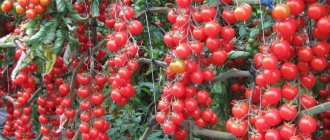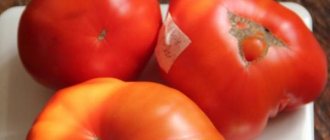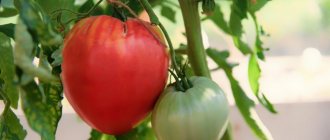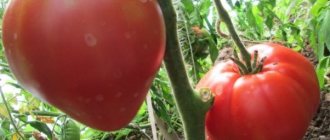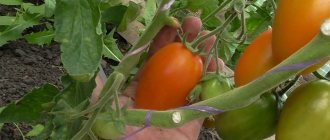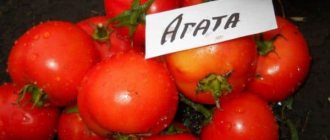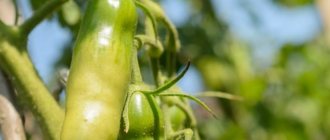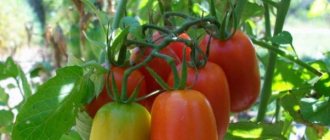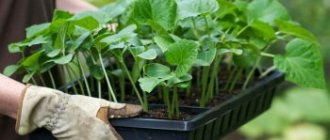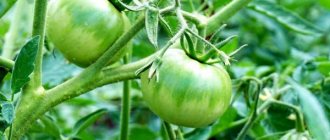» Vegetable growing » Tomatoes » Tomato variety Red Pear
0
1174
Article rating
The Red Pear tomato is deservedly popular and in high demand among gardeners. And this is not surprising, because it is known for its remarkable characteristics: fresh tomatoes have excellent taste, they are also good for heat treatment, the care rules are very simple, which is very convenient for beginners.
- Advantages and disadvantages
- Features of growing tomatoes
- Care
- Reviews from gardeners about the variety
Tomato variety Red Pear
Description of the variety
The mid-season variety Red Pear was bred by breeders of the Research and Production Corporation NK.Ltd.
Introduced into the State Register of the Russian Federation in 2000. The crop is intended for cultivation in small and large farms in closed and open ground.
The plant is indeterminate and needs staking and shaping.
The photo shows the fruits of the Red Pear variety.
The distinctive features of the variety are presented in the table.
| Indicators | Characteristic |
| Weight | 45-70 g |
| Form | Pear-shaped |
| Coloring | Red |
| Leaves | Medium size, green |
| Type of inflorescences | Simple |
| peduncle | With articulation |
| Number of slots | 2-3 |
| Pulp | Dense, high in dry matter, but juicy |
| Taste | Classic sweet and sour |
| Skin | Smooth, dense, does not crack |
| Purpose | Universal |
| Bush height | In open ground - 1.3 m, in closed ground - 1.5-2 m |
| Ripening period | 110-115 days |
| Productivity | 5-7 kg/m² |
| Sustainability | To verticellosis, tobacco mosaic virus, fusarium |
| Transportability | Excellent |
Advantages and disadvantages
Pros:
- unusual shape;
- pleasant taste;
- the skin does not crack during processing;
- suitable for preservation.
- extended fruiting;
- resistance to late blight;
- The fruits are perfectly stored and do not wrinkle during transportation.
Minuses:
- decent yield only on nutrient-rich, loose and light soils.
- you have to constantly monitor the growth of green mass of plants and tie them up in time.
- does not tolerate drafts.
Growing seedlings
Sowing seeds is done in two ways: in seedling boxes and directly into the ground. The first method is used in the northern regions and areas of the middle zone. The second method is practiced in the south of the country.
Preparing soil and seeds
Sowing work is planned approximately 2 months before transferring the seedlings to a permanent place. The optimal period is the last ten days of February or the first ten days of March. Seeds collected by hand from previously grown tomatoes are processed. They are soaked in a slightly pink solution of potassium permanganate for 2 hours, then washed with clean water.
Seeds in packaging are processed in production.
Soaking in germination stimulants: “Epin”, “Zircon”, “Immunocytophyte” will not hurt. Folk remedies are also popular:
- Aloe juice is diluted with water in a 1:1 ratio and the seeds are immersed in the solution for 4-6 hours.
- A teaspoon of bee honey is dissolved in 200 ml of warm water and the grains are soaked for 5-6 hours.
The soil for growing seedlings is prepared from equal parts of turf, peat and river sand, or a ready-made substrate is used in bags marked “universal”. The soil, prepared independently, is fertilized with organomineral compositions “Ogorodnik” and “Universal”. They contain substances necessary for rapid growth and nutrition of plants: potassium, magnesium, phosphorus, sodium, sulfur, iron, zinc.
Advice. For the purpose of disinfection, the soil mixture is calcined in an oven at a temperature of 100-110 ° C or filled with a strong solution of potassium permanganate.
Sowing
The seedling boxes are filled with moist soil and the seeds are placed in furrows 2 cm deep at a distance of 2-3 cm. Sprinkle the top with a 1 cm layer of soil and cover with glass or cling film. The boxes are taken to a dark place. The seeds hatch after 4-5 days at a room temperature of 25 °C.
The cover is removed daily to ventilate the soil and prevent mold.
Seedling care
After the sprouts appear, the boxes are placed in a sunny place . They try to maintain the air temperature within 22 °C. If there is a lack of sunlight, phytolamps are installed above the seedlings at a height of 60-70 cm.
Seedlings are transplanted into individual pots after the first true leaf appears. Plastic containers or peat glasses are suitable for this purpose.
Seedlings are provided with moderate watering 1-2 times a week. Fertilizers “Agricola” and “Effekton” are used for feeding once every 14 days.
Orange pear-shaped tomatoes
Description of the Orange Pear variety may be of interest to lovers of yellow and orange tomatoes. Ideally smooth fruits have a wonderful taste. You can make a delicious salad from them or use them for preparations. The size of the tomatoes is smaller than average - tomatoes weigh from 50 to 80 g.
Up to 6 kg of fruits are harvested from bushes grown in greenhouse conditions, and more than 20 kg per square meter. In open ground, these figures are not much lower, and will suit any summer resident quite well.
Agricultural technology of tomatoes
The rules for growing the variety are standard: removing the shoots, shaping the plants into 2 stems, tying them to stakes or trellises, moderate watering and fertilizing.
Landing
Transferring seedlings to the greenhouse begins in late April or early May, and to open ground - at the end of May or early June. The soil should warm up to a temperature of 16-18 °C. In the first week after planting, the crop is provided with gentle conditions: shaded from the scorching sun and protected from drafts.
Soil preparation begins in the fall. The area is dug up and one 10 liter bucket per 1 m² is added. In spring, the soil is loosened again and fed with humus - 10 liters per 1 m².
Reference. To plant bushes, select an area where white cabbage, cauliflower, peas, beans, parsley, and onions were previously grown.
Holes for seedlings are dug at a depth of 15-20 cm, filled with a concentrated solution of potassium permanganate or boiling water, and 3-5 g of superphosphate are added. The seedlings are moistened abundantly and transferred into holes with a lump of earth. Seedlings in peat pots are planted directly into them. The soil is poured to the level of the lower leaves. This helps the plant take root faster.
Planting pattern – 40x60 cm, 3 bushes per 1 m².
Care
Regularity is important in caring for Red Pear tomatoes. Plants are watered moderately, fed with organic matter and mineral compounds, hilled up to strengthen the root system, loosen the soil and remove weeds.
Mulching the soil with agrofibre, straw, hay, sawdust, and pine needles will help make the maintenance task easier. Mulch inhibits the growth of weeds, prevents the formation of a hard crust on the surface after watering and prevents late blight infection.
Tomatoes are earthed up 10 days after planting, after thoroughly moistening the soil. Repeated hilling is carried out after 14 days.
Water calculation for each tomato bush is 1 liter. Pear-shaped varieties do not tolerate overwatering. Excessive moisture leads to rotting of the rhizomes, and the fruits also begin to deteriorate.
For fertilizing use organic matter and mineral fertilizers (once every 2 weeks):
- The first portion of nitrogenous fertilizers is applied 14 days after planting - 1 liter of mullein, 1 liter of green fertilizers (based on tops and mown grass), 1 liter of ash per 10 liters of water.
- Subsequent feeding is carried out with ready-made mineral compositions every two weeks: “Kemira”, “Rastvorin”, ammophos, nitrophoska, nitroammophos. The dosage and method of use are indicated on the packaging.
The bushes are regularly planted and formed into 2 stems. This technique allows you to obtain a consistently high yield. The lower leaves are regularly plucked off to improve air exchange.
Plants are tied to tall wooden stakes or trellises.
Features of cultivation
The Red Pear variety is grown without seedlings, following the recommendations:
- Tomatoes prefer loose and nutritious soil. The soil is dug up 2-3 weeks before sowing and potassium-phosphorus fertilizers are applied. The area is sprinkled with wood ash at the rate of 2 kg per m².
- The seeds are placed in holes 1.5 cm deep at a distance of 40 cm.
- After sowing, the soil is moistened abundantly with warm, settled water and covered with film or lutrasil.
- After warm weather sets in, the shelter is removed.
- Seedlings are thinned out if necessary and weak shoots are removed.
- Further care includes fertilizing, weeding, watering and loosening. During fruiting, watering is limited to prevent cracking of tomatoes.
- The garter is made when the height reaches 40-50 cm.
Reference. Lutrasil is a modern covering material. Made from polymer threads tightly woven together. Protects plants from sub-zero temperatures, retains heat, and allows moisture and air to pass through perfectly.
Diseases and pests
The Red Pear variety is resistant to fusarium, verticillium, and tobacco mosaic virus. Preventative measures will protect plants from late blight infection.
Signs of the disease:
- brown spots with a gray tint on stems, leaves, fruits;
- white coating with edges on the back of the leaves;
- deformation of tomatoes.
Methods of prevention and control:
- soil disinfection with copper sulfate (50 g of substance per 10 l of water, consumption per 1 m² - 2 l);
- treatment of greenhouses with sulfur bombs;
- removal of lower foliage;
- humidity level control;
- organization of drip irrigation;
- mulching with sawdust, peat, agrofibre, pine needles, straw.
To combat insect pests (aphids, spider mites, whiteflies) use:
- insecticides - “Aktara”, “Sirocco”, “Decis Profi”, “Mospilan”, “Borey”, “Iskra”, “Epin”;
- biological preparations – “Fitoverm”, “Bitoxibacillin”, “Fitosporin-M”, “Nemabakt”.
PHYTOPHORA ON TOMATOES - ENEMY No. 1. [An effective way to fight.]
Care
Seeds are sown two months before the planned planting
Mandatory conditions for successful yield:
- abundant irrigation with loosening of beds;
- garter to support;
- application of fertilizers.
It is better to water the crop with warm, clean water after sunset. Both soil and closed greenhouses provide high yields.
During the fruiting period, it is necessary to significantly reduce watering so that the peel does not crack.
Important Tips:
- seedlings cannot be planted in the ground until it warms up to 15-18°, i.e. until the end of May or beginning of June;
- start fertilizing the soil already when growing seedlings: first provide fertilizing containing nitrogen immediately after sprouting;
- then fertilize the soil twice more, every 3 weeks;
- Before the formation of crop ovaries, feed with phosphorus-potassium fertilizers, pour in infusion of nettle or ash, for favorable development and strengthening of the root system.
According to the description, it is worth planting 3 plants per m² when creating a bush with 2 stems. For a more compact arrangement - 4 pcs/m² - a 1-stem formation scheme is appropriate.
The following is the usual care:
- watering;
- loosening;
- stepsoning;
- tying to supports.
Compliance with these simple rules will guarantee a bountiful harvest.
After the ovaries appear, replace nitrogen fertilizers with phosphorus and potassium fertilizers. But such fertilizing should be administered no more than 2 times during ripening.
The red pear is beautiful, but small!
Red pear tomato. Brief overview, description of characteristics, where to buy solánum lycopérsicum seeds
SLAVIC MASTERPIECE – TARASENKO JUBILEE – RED PEAR – SOWING TOMATOES
The nuances of growing in open ground and in a greenhouse
The agricultural technology of tomatoes in protected and unprotected soil is not fundamentally different.
The period for transferring tomatoes into open and closed ground varies depending on the region of growth. In the northern regions and regions of the middle zone, planting is carried out in early May in greenhouses. In the southern regions, seedlings are planted in open ground in early June. For planting, choose a sunny area without drafts.
The greenhouses are kept open during the day and closed at night.
After the fruits appear, the frequency of watering is reduced to once a week. In dry weather, plants are watered more often.
Advantages and disadvantages
Let's find out all the advantages and disadvantages of this variety of tomatoes.
pros
- The Red Pear variety exhibits high resistance to the most dangerous diseases of nightshade crops - late blight and others.
- The seeds have a high germination rate, which makes it possible to save money and preserve the harvest to the maximum.
- The fruits contain a high content of carotene, which is beneficial for human health.
- The taste of tomatoes is excellent, the use of the fruit is universal.
- The fruiting period is extended over time, thanks to which it is possible to collect the maximum amount of harvest during the season.
- Tomatoes can be stored for a long time without losing their appearance or taste. In addition, they withstand transportation well due to their density.
Minuses
- The Red Pear tomato has high demands on the composition of the soil. It will not grow anywhere.
- Due to the indeterminate properties of the plant, when growing it you cannot do without pinching and staking.
- Poor draft tolerance often makes it impossible to grow crops in open ground.
Other varieties of the variety
The table contains the main characteristics of other varieties from the Pear series.
| Yellow | Orange | Black | Pink | Honey | |
| Ripening period | 100-110 days | 95-115 days | 110-125 days | 110-115 days | 90-100 days |
| Bush height | 2-2.5 m | 1.5-1.8 cm | 1.6-1.8 m | 1.5-2 m | 1.2-1.5 m |
| Skin | Dense | Dense | Dense | Dense | Dense |
| Weight | 80-100 g | 40-60 g | 60-100 g | 80-100 g | 30-40 g |
| Coloring | Yellow | Bright orange | Burgundy brown | Pink | Yellow |
| Taste | Sweet | Sweet, sour | Very sweet | Sweet | Sweet |
| Productivity per 1 m² | 6-8 kg | 6-7 kg | 6-8 kg | 6-7 kg | 7-8 kg |
All crops are distinguished by ease of care, productivity and long shelf life of fruits, absence of voids and a small number of seeds.
Orange pear tolerates heat and cold better than others. The fruits of the Black Pear variety have a unique rich color and contain an increased amount of sugar.
Pear-shaped tomatoes in cooking
All pear tomatoes are excellent for preparing vegetable salads, canning and processing. The small size of the fruits and the thick skin on them allow you to pickle and salt tomatoes without fear that they will crack over time. Housewives pickle different types of Pear tomatoes in one jar - on the table pink, black, orange, red, even purple Evans varieties look unusually beautiful.
Tomatoes do not have to be canned whole. They are excellent for preparing vegetable salads, ketchups, pasta, and lecho. The juice turns out thick. Due to the excellent table taste of the pulp, this juice is very popular, but before use it is diluted with boiled water.
Tomatoes are used in the preparation of hot dishes or vegetable caviar. They are good as a component of pizza or casseroles. The flesh is dense, they are stuffed, dried and, of course, frozen.
Olga Danilina
Reviews
Feedback from farmers about the Red Pear variety is mostly positive.
Valentina, Dzerzhinsk: “I grow Pear in a greenhouse. I prefer to buy seeds so as not to bother with preparations for the next season. I plant red and yellow tomatoes, and then seal them in a marinade for the winter. This preparation looks great in a jar. The variety is easy to care for and rarely gets sick. The taste of the fruit is rich, sweet and sour.”
Ivan, Sosnovy Bor: “Red Pear tomatoes are my favorite variety. Easy to care for, disease resistant, combined with an original shape and excellent taste. All this helped the culture take pride of place in my greenhouse. During 5 years of cultivation, the plants became infected with late blight only once, but the problem was quickly resolved by treating them with Fitosporin. We eat tomatoes fresh and can them.”
Application area
The scope of application of the “Pear” series of tomato varieties is very extensive.
Thanks to their unusual shape, small size and thick skin, tomatoes are perfect for whole-fruit canning. Tomatoes of different colors will look beautiful in a jar.
Important! To obtain a bountiful harvest, you need to form a bush in time into two stems and pinch the top after forming 7 or 8 full clusters.
“Pear” tomatoes of any variety are actively used in preparing preparations for the winter as a component of all kinds of salads, lecho, and ketchup. Tomato juices are very thick and rich. Tomato paste made from red tomatoes will be thick due to its dense pulp and high solids content.
Due to the unusual shape of tomatoes, the surface attachment of the stalk is the reason for reducing waste when preparing dishes. Tomatoes of the “Pear” series are used in food and fresh, as well as as slicing, for preparing fresh salads, and decorating ready-made dishes.
Tomatoes are also widely used in the preparation of main courses, when baking various casseroles and pizzas, whole roasting and stuffing. Perfectly retains taste and aroma during freezing and drying.
Preparing and planting seeds
Follow the rules when planting seeds
To successfully grow Red Pear tomatoes, you need to properly prepare the seeds for planting. Professional advice will help you with this.
- If you decide to grow a variety of pear-shaped tomatoes for the first time, you should purchase seeds in advance. This can be done both in the store and on the market or via the Internet, where there is a huge selection of different manufacturing companies. For example, many gardeners prefer Aelita.
- First, soak them in a 1% solution of potassium permanganate. This will not only disinfect the seeds, but will also help sort out the options that are unsuitable for planting (during this procedure they will certainly settle to the bottom of the glass).
- You should be very careful when choosing soil for planting seeds. It is best to mix regular soil with peat and humus, or buy ready-made soil in specialized stores.
- It is best to sow healthy material in small containers, such as plastic cups. Do not pour more than 2-3 seeds into one container, because when they germinate, they will interfere with each other very much.
- Once finished, the containers should be hidden in a dark place. Don't forget to cover them with plastic wrap when loading.
- Wait for the sprouts to hatch, remove the film, and transfer the seedlings to a bright and well-lit place. This could be a kitchen or a balcony, but it must be insulated.
- It is necessary to grow seedlings until they have 5-6 leaves.
Description of the original Red Pear tomato and recommendations for growing the variety
The Red Pear tomato is the original variety of tomatoes. Its distinctive feature is its unusual-looking fruits, which are shaped like pears. Gardeners are unanimous in their opinion that Red Pear tomatoes have a wonderful, rich taste that cannot be confused with other tomatoes.
People's reviews of this variety are positive. Everyone who planted this variety was satisfied with the large harvest, its quality and the ease of growing the crop.
What is a red pear tomato?
Characteristics and description of the variety:
- The tomato belongs to the mid-season varieties. The fruits can be eaten or stored for the winter about 110 days after the first sprouting of seedlings.
- The fruits are bright red, pear-shaped. The average weight of 1 tomato is 60-80 g. The pulp is dense, sweet and sour. The fruits have few seeds and almost no voids.
- This is an indeterminate variety, that is, the plant is tall. The height of the bush can reach 1.5 m. 2 trunks are formed in 1 bush. Due to this, it has high productivity.
- You can grow vegetables both outdoors and in greenhouses.
- High yield. Experienced gardeners harvest more than 2 kg of tomatoes from 1 bush.
- Rich classic taste. Red Pear tomatoes are suitable for eating fresh or as homemade preparations for the winter. Bright pear-shaped tomatoes will decorate any table and are suitable as ingredients for various dishes.
- The fruits are stored for a very long time. Tomatoes can remain fresh for about 1.5 months without losing their shape or taste. The main condition is that the storage temperature should be about +2…+3ºС.
- Tomato is not afraid of transportation. Boxes of fruit can be transported over long distances without fear.
- Each fruit contains a large amount of carotene, which protects the human body from cancer. Tomatoes also contain many other beneficial substances and vitamins.
- Red Pear tomatoes are demanding on soil. For them, gardeners prepare the soil in advance. It must be fertilized with phosphorus, potassium, humus, and ash.
- The plant does not like piercing wind. Gardeners try to plant Red Pear tomatoes in a place that will be protected from strong winds. At the same time, the tomato tolerates heat well.
- The bush must be constantly pruned and excess leaves removed.
How to grow tomatoes?
Let's consider the features of growing the Red Pear tomato, a description of agrotechnical measures. Seedlings are usually planted in March. Seeds take root better in the soil mixture. Next, the boxes containing the seedlings are covered with cling film. A necessary condition for germination is that the air temperature should be around +25ºС. After germination, the boxes are placed where there is a lot of light. The seedlings are transplanted as soon as 3 leaves appear.
Plants are planted on the site in May. It is necessary for the earth to warm up to +15ºС. Experienced gardeners plant 2-3 bushes per 1 m². In order to grow a good harvest, tall stems are tied and secured to stakes. Bushes are pruned once a week.
Gardeners advise watering the bushes generously with warm, settled water every few days. It's good if it's rainwater. After watering, loosen the soil and remove weeds. Feeding is carried out several times per season. Preference is given to mineral and organic fertilizers and ash.
Bushes of the pear variety are sprayed with drugs against pests and fungal diseases. The greenhouse is constantly ventilated. It is usually opened during the day and closed in the evening. After the fruits appear, gardeners begin to water the crop more moderately. Too much water can cause tomatoes to crack.
The Red Pear variety can be grown in almost all regions of our country. The exception is the north. A new variety has been created especially for Siberia - the Siberian red pear tomato. The advantages of this culture are its cold resistance. The characteristics and descriptions of the variety include its resistance to late blight, early ripening of fruits, and the ability of tomatoes to be stored for a long time.
Diseases and pests
Diseases that affect the Red Pear tomato are most often of a fungal nature. To avoid their appearance, it is recommended to ventilate the greenhouse and spray the plantings with Bordeaux mixture from mid-July.
The Red Pear tomato is an excellent vegetable for growing in your garden. The hours spent caring for the plantings will pay off handsomely in tens of kilograms of high-quality, tasty fruit.
If you find an error, please highlight a piece of text and press Ctrl Enter.
“Yellow Pear” will not cause much trouble for the gardener, as it has innate resistance to the main diseases of tomatoes:
- Late blight;
- Fomoz;
- Tobacco mosaic.
Due to a lack of calcium and magnesium in the soil, the variety is affected by apical or white rot. Tomatoes in greenhouses are often infected with white rot due to their proximity to other vegetable crops. When the first signs of the disease appear, rotten shoots are destroyed, sometimes the entire bush is disposed of.
To prevent fungal and viral diseases, at the beginning of growth, tomatoes are treated with a solution of potassium permanganate. For the Colorado potato beetle, bushes in the greenhouse and in the open area are treated with a standard solution of toxic chemicals. To prevent slugs, caterpillars and other crawling pests, sprinkle the roots of the bushes with copper sulfate. Treatment with chemicals is carried out at the beginning of bush growth, then once a month.
Characteristics
- The pink pear also belongs to the mid-season variety. The first tomatoes begin to ripen 110 - 120 days after the emergence of full shoots. The onset of ripening is directly related to climatic conditions;
- the yield of marketable fruits, according to the State Register of Varieties of the Russian Federation, is slightly higher than that of its red predecessor. It is 6.1 - 6.7 kg per 1 square meter. According to data from various sources, up to 3 kg of tomatoes can be harvested from one bush;
- tomatoes do not crack during ripeness;
- stress resistance is good, the plant adapts to weather changes;
- resistance to major diseases is high;
- seed germination 80 - 90%;
- The transportability and keeping quality of the fruits are excellent, they can withstand transportation and storage without loss of presentation and taste;
- The way to eat tomatoes is universal. The fruits of this variety are recommended for use in their natural form. Pink pear is also perfect for whole-fruit canning and pickling.
Characteristics
- The red pear belongs to the mid-season variety. From the moment of the appearance of full shoots until the beginning of ripening, 110 - 115 days pass;
- the harvest period lasts from July to September;
- the yield of commercial products, according to the State Register, is 5.0 - 5.6 kg per 1 square meter. One of the seed producers, SeDeK, declares this figure to be slightly higher - 7.0 - 8.0 kg per 1 sq. meters;
- the variety is stress-resistant, adapts well to environmental changes;
- Tomato is highly resistant to major crop diseases;
- The transportability of the fruits, due to their dense structure, is excellent. On the road they do not lose their presentation;
- during storage, the marketability and taste of fruits do not deteriorate;
- The way to eat tomatoes is universal. Red pear is recommended for fresh use. The consistency and shape of the fruits are ideal for canning;
- seed germination is high - 80 - 90%.
